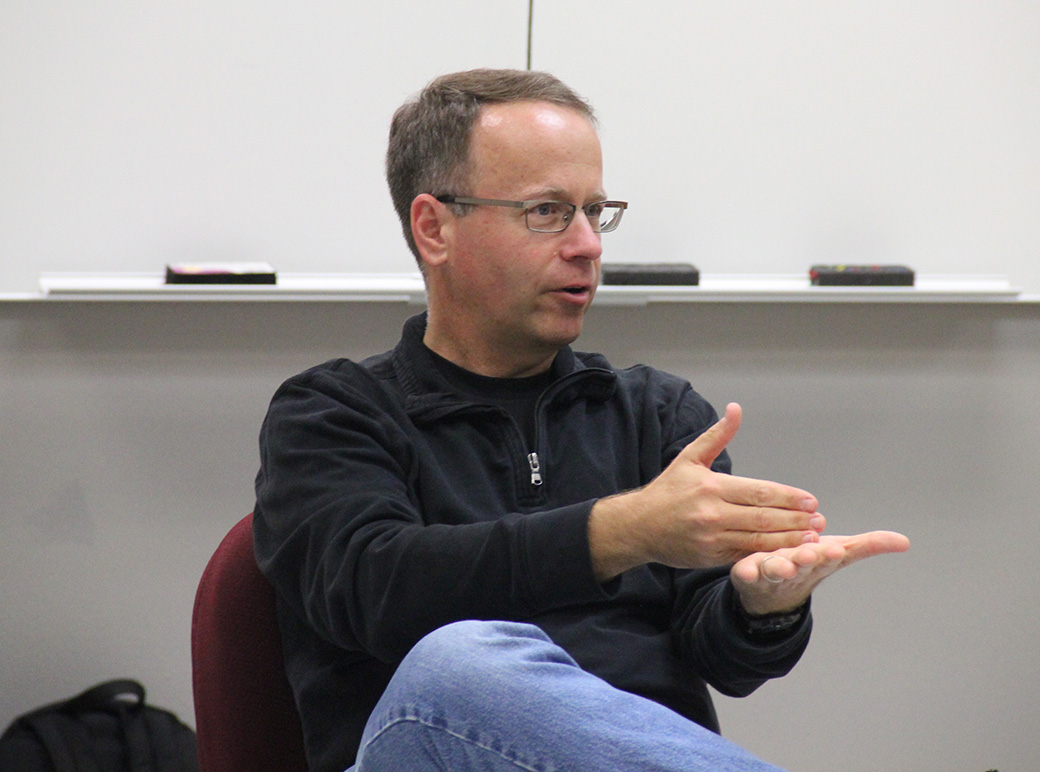
Pulitzer Prize-winning photojournalist visits USD
An image is said to be worth 1,000 words, but for one community photojournalist it was also worth the Pultizer Prize.
Robert Cohen, a Pulitzer-Prize winning community photojournalist, visited USD last Thursday. Cohen, an employee of the St. Louis Post-Dispatch, won his Pulitzer for his photographic coverage of the turmoil in Ferguson, Missouri, after the death of Michael Brown in 2014.
While at USD, Cohen visited classes to talk about his experiences as a photojournalist. In the evening, he gave a talk at the Al Neuharth Media Center about his experiences at the Ferguson protests.
The spark that set Ferguson on fire occurred on Aug. 9, 2014, when Michael Brown, an 18-year-old black man, was shot by a white police officer, Darren Wilson. The circumstances of the shooting became a media sensation, and protests rocked Ferguson immediately after the shooting and again in November when a grand jury declined to indict Wilson in the shooting.
The initial wave of protests lasted for more than two weeks, during which time Cohen snapped a now-famous picture of protestor Edward Crawford hurling a can of tear gas at police.
Michelle Van Maanen, the chair the of media & journalism department, expressed enthusiasm about Cohen’s day on campus.
“The mission we have for our students (includes) having opportunities to hear from those who are out in the field and extremely successful at what they do and Robert Cohen is at the top of his game,” she said.
Cohen worked for his high school newspaper before going on to the University of Texas, where he wrote for the Daily Texan. After graduating, Cohen worked for newspapers in Louisiana, Florida and Tennessee before making his way to the Post-Dispatch.
There he learned the three most important aspects of being a journalist:
“You have to be persistent, patient and curious about your community,” Cohen said.
Being a community photojournalist means trying to capture the feeling of living in an area — the St. Louis area in Cohen’s case. Before Ferguson, he covered various stories about the St. Louis Cardinals, a historic site along Route 66 and the Joplin tornado.
This interest in the community led him to Ferguson during the extreme unrest following Brown’s death and Wilson’s acquittal, he said. There was no immediate indication that the demonstrations would become so massive, but Cohen was there as soon as there were signs of trouble brewing.
“Originally, we only had a skeleton crew in Ferguson,” Cohen said. “Once the looting began, that’s when we knew it was going to be big.”
The presentation Cohen gave included a 20-minute documentary featuring footage and photographic coverage of the protests and interviews with citizens and local officials.
His work had been lauded by peers for years and he was a previous two-time Pulitzer Prize finalist. In 2015 he finally won the prestigious award, along with the rest of the photographers on the Post-Dispatch staff, for their work covering the protests.
“I was photographing my coworker’s reactions,” Cohen said when he recalled winning the Pulitzer Prize. “While it’s an honor, in the end, there’s still an 18-year-old kid lying in the street.”
The photo he took of Crawford throwing tear gas back at the police was included in the portfolio that received the Pulitzer.
“It was at the end of the night, when people were going home,” Cohen said about the photo. “When another protest began, police started firing tear gas to disperse the crowd. This was the first time I’ve seen someone actually pick up the can and throw it back… I knew it was going to be different. When I looked through the photos, that’s when I noticed he was wearing an American flag shirt. I tweeted it out before I went to bed and when I woke up, it was everywhere. It was his body posture, the act of fighting back, it was his shirt, it was his bag of potato chips in his other hand.”
Cohen was one of only three photographers allowed at Michael Brown’s funeral (the others being from the New York Times and the St. Louis American).
Hanna Conrad, an English graduate student, attended the event with her friends. She compared Cohen’s work to the work of the national media outlets.
“Community journalists focus on individual stories, not just the big picture,” she said. “The effect on lives is often overshadowed when big media comes to town.”
Cohen talked about the national media coming to Ferguson.
“The national media were more focused on the looting and the fires, I wanted to know what it was like for the citizens living through it,” he said.
He described the night Wilson was acquitted as the “scariest night I ever worked in journalism.”
Cohen recalled people boarding up windows and building fences ahead of the decision.
“I’ve never seen a fence go up that fast,” he said.
The many plywood pieces would later be used as canvas for artists.
He also in Ferguson for the the one-year anniversary of the shooting, and photographed the shooting of another black man, who later survived.
The Ferguson protests, Cohen said, helped launch a much-needed discussion about race relations across the nation.
“The unrest opened a very serious racial can of worms that should’ve been opened 40 years ago,” he said.

